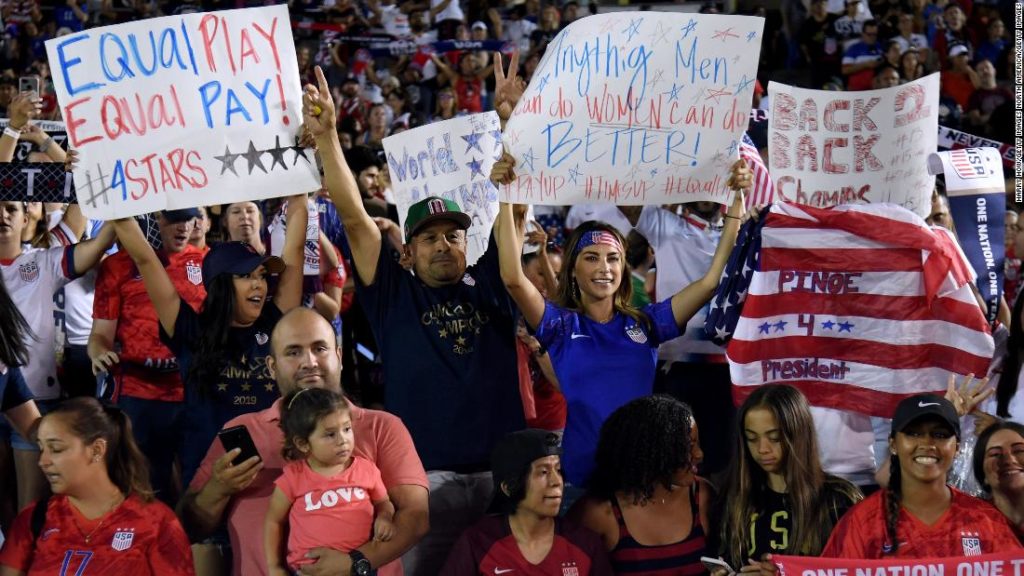The dumbbells — or lack thereof — represented a heavy truth for female athletes in the United States.
“It was just like, enough is enough,” said Olympic gold medalist and former national hockey team captain Meghan Duggan. “We’re a generation of women (who) are ready to use our voices and stop saying, you know, ‘Oh, we should be thankful for what we do have.'”
Women on the team, like star forward Alex Morgan, have maintained they’ve had to work harder and execute at a much higher level on the world’s stage to make the money they have.
“Our contracts are not apples to apples, they’re different,” Morgan said. “The benefits that we receive are different from the men …
“It’s really breaking those down line by line and making sure that we have the ability to make as much as a man would, given the amount of games we play and the teams we play and the success that we’ve had on the international stage.”
But USSF maintains the women negotiated a contract that provides them more stability than the men’s team.
Parlow Cone stressed that she and USSF are “100% committed to equal pay,” but “the main challenge is this massive discrepancy in FIFA’s World Cup prize money.”
“FIFA awards more money to our men’s team for qualifying for the World Cup than our women’s team gets for winning,” Parlow Cone noted. She said USSF has asked the men’s and women’s teams “to get together with US Soccer so we can a find a way to equalize (the FIFA World Cup prize money) between the teams.”
Overall, the average salaries of professional female athletes are making small-scale gains over time. But the pay gap is still wide. Millions of dollars separate the women and men when it comes to average annual salaries in professional hockey and basketball.
Many WNBA players still must play overseas to provide for their families.
WNBA star Candace Parker says it’s not about making a salary equal to the men, but ensuring women are given a platform to succeed.
“I’m a realist. You know, I realize that the WNBA is 25 years young. The NBA has been around for 75 years.” Parker says. “I understand that just because LeBron makes $90 million a year, it doesn’t (mean I should).
“But it’s the perception of what women athletes are, in the sense that they cannot sell …
“We’re seeing now that women athletes are able to point to their social media following and are really honestly able to monetize that.”
Parker is not the only prominent female athlete or executive to point to corporate investment as the area that can have a tangible effect on closing the pay gap.
Diversity in the business sector is a key to the push for equal pay in sports, coaching legend Muffet McGraw says.
“We need to hire more women at the administrative level, we need to hire them to be leaders of companies, so that we can change the discrimination that exists and the pay,” said the former Notre Dame women’s basketball coach. “When you sit in a room and you have all white men on a board doing the hiring, they’re going to hire people who look like them. We need to get more women in there so we can get a more diverse culture.”
WNBA commissioner Cathy Engelbert has an acute understanding of the impact that the C-suite can have on women’s sports. Engelbert was the first female CEO of Deloitte before joining the league in 2019.
“It is important to make sure there’s investment, and that it’s viewed as investment in women’s sports, to drive the economic model so we can pay the players more, give them better benefits and better travel,” she said.
“If 85% of all consumer purchasing decisions are made or influenced by women, and you’re a women’s professional sports team that skews more toward women fans, you just have to get the narrative right so that companies can see the value of supporting women’s professional sports.”
In 2020 for example, Engelbert said WNBA viewership was up 68% over a crowded sports landscape. She believes that comes with exposure on larger networks, coupled with a commitment to storytelling and building the narratives of household names.
Social media platforms for young women are also a transformative tool. Now more than ever, young women are speaking up when they see gender inequity.
And there have been some positive signs. At the end of last month, Michelob Ultra committed $100 million to marketing women’s sports over the next five years.
And AIG set a new benchmark in the LPGA with a total payout of $5.8 million for the tournament they sponsor.
One of the titans of gender equity, Billie Jean King, summed up what so many women in sports feel:
“As a girl growing up, I was always taught to be so grateful for the crumbs. Women are taught that. No more. We are only going to be happy with the cake, the icing and the cherry on top. We deserve it, and we’re going to go for it. No more being happy with the crumbs.”
You may also like
-
Super League: UEFA forced to drop disciplinary proceedings against remaining clubs
-
Simone Biles says she ‘should have quit way before Tokyo’
-
Kyrie Irving: NBA star the latest to withhold vaccination status
-
Roger Hunt: English football mourns death of Liverpool striker and World Cup winner
-
‘Every single time I lift the bar, I’m just lifting my country up’: Shiva Karout’s quest for powerlifting glory

